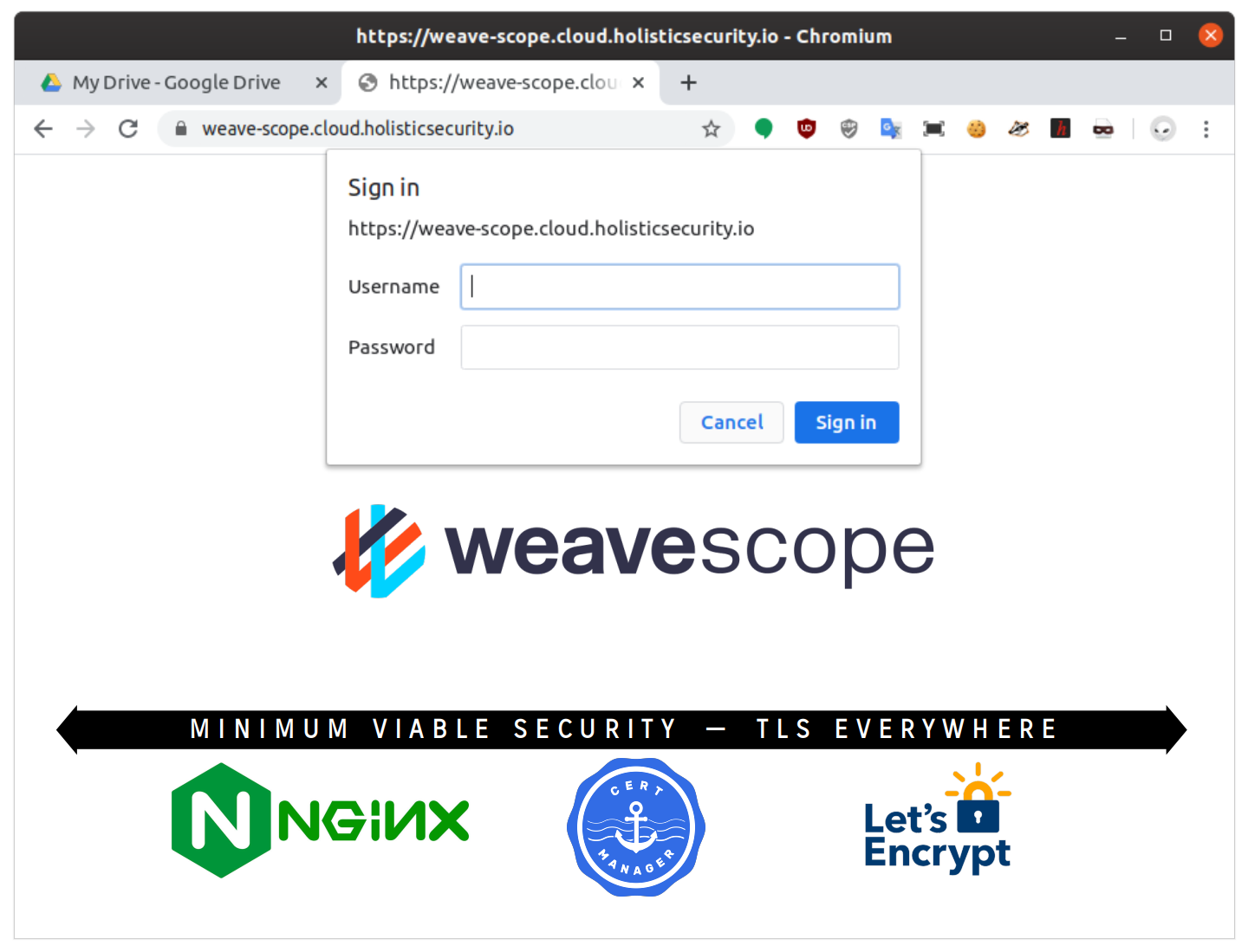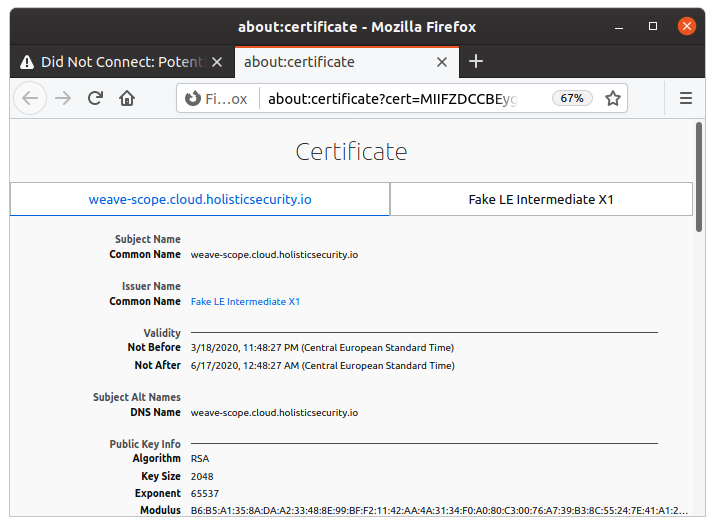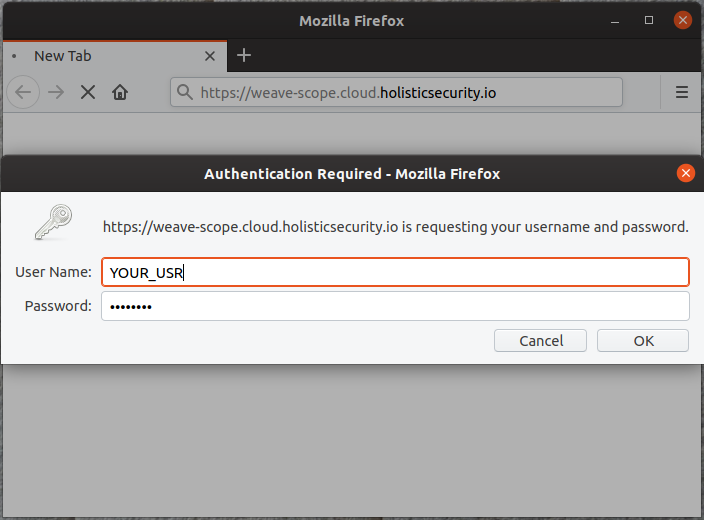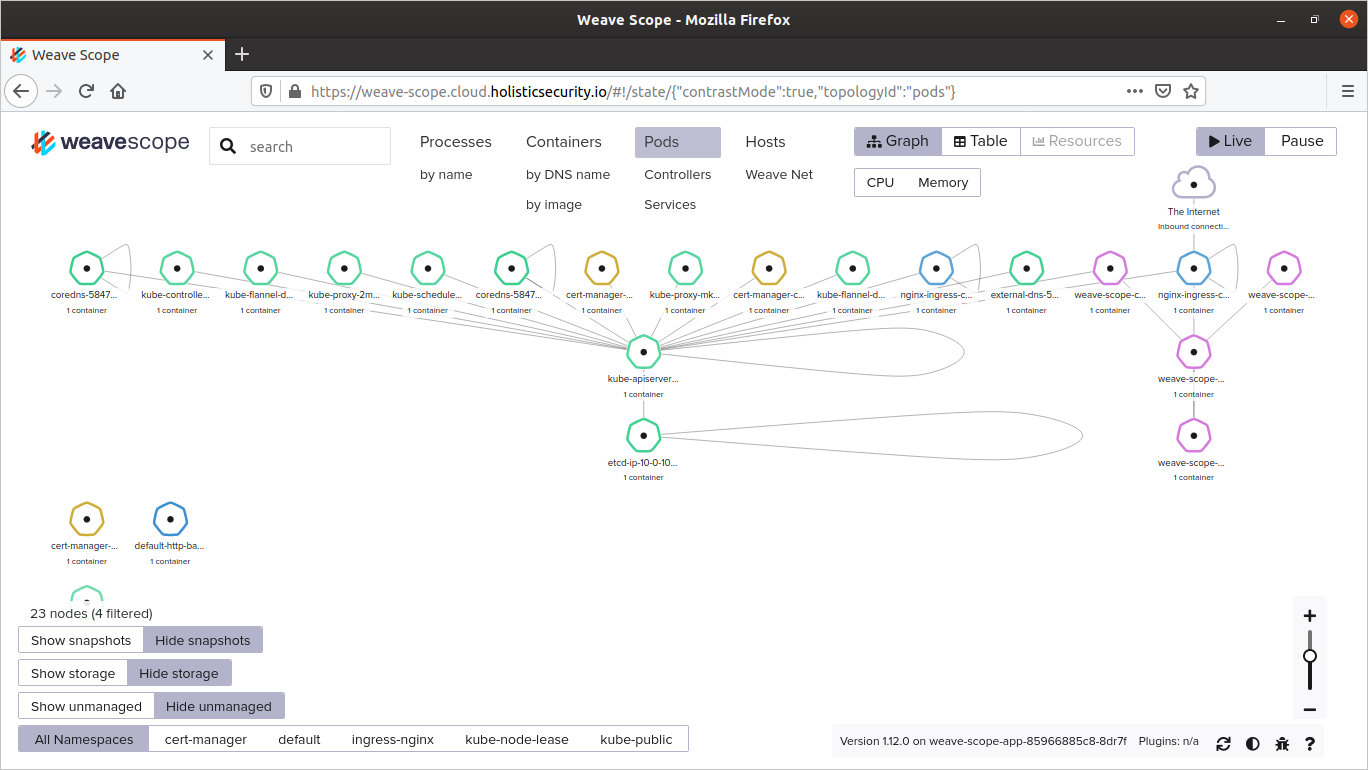Minimum Viable Security for a Kubernetised Webapp: HTTP Basic Auth on TLS - Part2
-
Cloud · Service Mesh ·
In the Minimum Viable Security for a Kubernetised Webapp: TLS everywhere - Part1 I used the Affordable K8s’ Terraform scripts to create a K8s Cluster with the Jetstack Cert-Manager and the NGINX Ingress Controller pre-installed, now I want to improve the security of a Webapp hosted in that Cluster according the Minimum Viable Security (MVSec) and Pareto Principle or 80/20 rule.
In this post I’ll explain how to enable and configure HTTP Basic Authentication over TLS in the Weave Scope webapp running in the recently created K8s Cluster.
Getting started
I recommend follow the Part 1 to get this scenario. Let’s explore the K8s services created.
$ kubectl get svc -n weave
- The
weave-scope-app-svc-npNodePort service will create theweave-scope.cloud.holisticsecurity.iosubdomain entry in AWS Route 53. - The
weave-scope-app-svc-npNodePort service is required when I’m getting access through SSH tunnel. - The
weave-scope-appClusterIP service was created when Weave Scope was installed.
Get access through SSH to your K8s Cluster and clone the Affordable K8s Git Repo. It contains all YAML files required for next steps.
$ ssh ubuntu@$(terraform output master_dns) -i ~/Downloads/ssh-key-for-us-east-1.pem
$ git clone https://github.com/chilcano/affordable-k8s
$ cd affordable-k8s/examples/
Since I’ll use HTTP Basic Auth, I need creating a K8s secret resources that the NGINX Ingress resources for Weave Scope will need.
$ sudo apt install apache2-utils -y
$ htpasswd -bc auth YOUR_USR YOUR_PWD
$ kubectl create secret generic secret-http-basic-auth --from-file=auth -n weave
Enabling and configuring HTTP Basic Authentication over TLS
1. Create a Let’s Encrypt Issuer
A Certificate issuer is the definition for where Jetstack Cert-Manager will get request TLS certs. An Issuer is specific to a single namespace in Kubernetes, and a ClusterIssuer is meant to be a cluster-wide definition for the same purpose.
In a scenario or project real, we should generate certificates for testing (staging) purporses, once tested the process to get and configure testing certificates, the next step is to get and use final (production) certificates. That is the reason I provide letsencrypt-issuer-staging.yaml and letsencrypt-issuer-prod.yaml. Then, let’s create both issuers.
$ kubectl apply -f letsencrypt-issuer-staging.yaml -n weave
$ kubectl apply -f letsencrypt-issuer-prod.yaml -n weave
Checking the Let’s Encrypt Issuers. If you got Reason: ACMEAccountRegistered, the Issuer is ready to issue certificates.
$ kubectl get issuer,secret -n weave
NAME READY AGE
issuer.cert-manager.io/letsencrypt-issuer-prod True 14s
issuer.cert-manager.io/letsencrypt-issuer-staging True 76s
NAME TYPE DATA AGE
secret/default-token-gzbzs kubernetes.io/service-account-token 3 7m30s
secret/letsencrypt-issuer-privkey-prod Opaque 1 12s
secret/letsencrypt-issuer-privkey-staging Opaque 1 74s
secret/secret-http-basic-auth Opaque 1 3m6s
secret/weave-scope-token-vb7vg kubernetes.io/service-account-token 3 7m31s
$ kubectl describe issuer letsencrypt-issuer-staging -n weave
$ kubectl describe issuer letsencrypt-issuer-prod -n weave
If you have under Status this Reason: ACMEAccountRegistered message in both issuers, that means they are ready to get certificates from Let’s Encrypt.
2. Create the Ingress resource with a Staging Certificate
$ kubectl apply -f weave-scope-app-ingress.yaml
With weave-scope-app-ingress.yaml I’ll have a testing certificate.
apiVersion: extensions/v1beta1
kind: Ingress
metadata:
name: weave-scope-app-ingress
annotations:
kubernetes.io/ingress.class: "nginx"
cert-manager.io/issuer: "letsencrypt-issuer-staging"
#cert-manager.io/issuer: "letsencrypt-issuer-prod"
nginx.ingress.kubernetes.io/auth-type: basic
nginx.ingress.kubernetes.io/auth-secret: secret-http-basic-auth
namespace: weave
spec:
rules:
- host: weave-scope.cloud.holisticsecurity.io
http:
paths:
- path: /
backend:
serviceName: weave-scope-app-svc-np ## NodePort
servicePort: 82
tls:
- hosts:
- weave-scope.cloud.holisticsecurity.io
secretName: cert-tls
When creating the TLS NGINX Ingress resources, the NGINX Ingress Controller underhood will execute the next steps:
- Request a TLS Cert through the Let’s Encrypt Issuer (
letsencrypt-issuer-staging). - Load the issued TLS Cert and its configuration to route the
weave-scope.cloud.holisticsecurity.ioincomming traffic over TLS to Weave Scope pods. - The HTTP Basic Auth annotations (
nginx.ingress.kubernetes.io/auth-type: basicandnginx.ingress.kubernetes.io/auth-secret: secret-http-basic-auth) will be used.
If everything looks good, you might check the K8s secret resource and the Let’s Encrypt Issuer resources (certificate, certificaterequest, order and challenge) details.
$ kubectl get ingress,secret,certificate,certificaterequest,order -n weave
$ kubectl describe secret cert-tls -n weave
Name: cert-tls
Namespace: weave
Labels: <none>
Annotations: cert-manager.io/alt-names: weave-scope.cloud.holisticsecurity.io
cert-manager.io/certificate-name: cert-tls
cert-manager.io/common-name: weave-scope.cloud.holisticsecurity.io
cert-manager.io/ip-sans:
cert-manager.io/issuer-kind: Issuer
cert-manager.io/issuer-name: letsencrypt-issuer-staging
cert-manager.io/uri-sans:
Type: kubernetes.io/tls
Data
====
tls.crt: 3610 bytes
tls.key: 1675 bytes
ca.crt: 0 bytes
$ kubectl describe certificate cert-tls -n weave
...
...
Events:
Type Reason Age From Message
---- ------ ---- ---- -------
Normal GeneratedKey 3m39s cert-manager Generated a new private key
Normal Requested 3m36s cert-manager Created new CertificateRequest resource "cert-tls-3240899713"
Normal Issued 2m2s cert-manager Certificate issued successfully
Now, if you open this url https://weave-scope.cloud.holisticsecurity.io in your browser you will get an error about Certificate desn’t Trusted and can not get access to Weave Scope. That doesn’t mean that Cert-Manager or Ingress Controller don’t work, that means specifically this:
weave-scope.cloud.holisticsecurity.io has a security policy called HTTP Strict Transport Security (HSTS), which
means that Firefox can only connect to it securely. You can’t add an exceptions to visit this site.The issue is most likely with the website, and there is nothing you can do.
3. Create the Ingress resource and getting a Production Certificate
In this point we are ready to get a certificate for production purposes, before we should remove the previous ingress resource and its corresponding generated secret.
$ kubectl delete ingress weave-scope-app-ingress -n weave
$ kubectl delete secret cert-tls -n weave
Edit the weave-scope-app-ingress.yaml.
$ nano weave-scope-app-ingress.yaml
Uncomment this line cert-manager.io/issuer: "letsencrypt-issuer-prod" and comment this other cert-manager.io/issuer: "letsencrypt-issuer-staging" in weave-scope-app-ingress.yaml file.
apiVersion: extensions/v1beta1
kind: Ingress
metadata:
name: weave-scope-app-ingress
annotations:
kubernetes.io/ingress.class: "nginx"
#cert-manager.io/issuer: "letsencrypt-issuer-staging"
cert-manager.io/issuer: "letsencrypt-issuer-prod"
nginx.ingress.kubernetes.io/auth-type: basic
nginx.ingress.kubernetes.io/auth-secret: secret-http-basic-auth
namespace: weave
spec:
rules:
- host: weave-scope.cloud.holisticsecurity.io
http:
paths:
- path: /
backend:
serviceName: weave-scope-app-svc-np ## NodePort
servicePort: 82
tls:
- hosts:
- weave-scope.cloud.holisticsecurity.io
secretName: cert-tls
Now create the updated ingress.
$ kubectl apply -f weave-scope-app-ingress.yaml
Check all resources created.
$ kubectl get ingress,secret,certificate,certificaterequest,order -n weave
NAME HOSTS ADDRESS PORTS AGE
ingress.extensions/weave-scope-app-ingress weave-scope.cloud.holisticsecurity.io 80, 443 68s
NAME TYPE DATA AGE
secret/cert-tls kubernetes.io/tls 3 66s
secret/default-token-gzbzs kubernetes.io/service-account-token 3 31m
secret/letsencrypt-issuer-privkey-prod Opaque 1 24m
secret/letsencrypt-issuer-privkey-staging Opaque 1 25m
secret/secret-http-basic-auth Opaque 1 27m
secret/weave-scope-token-vb7vg kubernetes.io/service-account-token 3 31m
NAME READY SECRET AGE
certificate.cert-manager.io/cert-tls True cert-tls 68s
NAME READY AGE
certificaterequest.cert-manager.io/cert-tls-1393507612 True 66s
NAME STATE AGE
order.acme.cert-manager.io/cert-tls-1393507612-2800536094 valid 66s
Now, if you open this url https://weave-scope.cloud.holisticsecurity.io in your browser you will be prompted for user and password to get access to Weave Scope.
Once authenticated, you will be able to check the TLS Certificate issued by Let’s Encrypt.
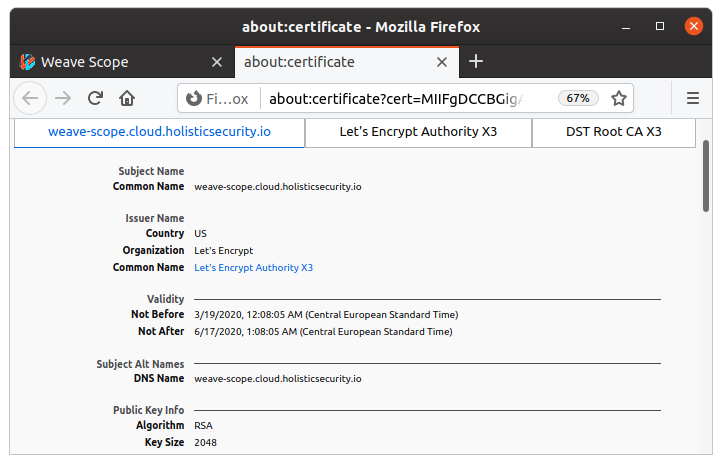
4. Troubleshooting with logs
Check the Cert-Manager logs to see if the TLS Cert, Keys, CSR, etc. were requested and approved successfully.
$ kubectl logs -f -n cert-manager -lapp=cert-manager
Check the NGINX Ingress Controller logs to see if the TLS Cert and configuration were created and loaded successfully.
$ kubectl logs -f -n ingress-nginx -lapp.kubernetes.io/part-of=ingress-nginx
Conclusions
You need a PKI
Let’s Encrypt technically can issue TLS Client Certificates, but it isn’t recommended because using Let’s Encrypt’s DV certificates directly as client certificates doesn’t offer a lot of flexibility, and probably doesn’t enhance overall security in most configurations. The best option would be to use your own CA for this process, as that allows for much more direct control, and client certificates don’t have to be publicly trusted by all clients, just trusted by your server.
For other side, at operationaly speaking, TLS Certificate Management (revocation, renewals, validation, etc.) is expensive, that means we will require a PKI with a powerful RESTful API to manage the Cert Lifecycle during the deployment of Containers-based Applications.
A PKI will be helpful allowing to create a private CA or Intermediate CA and manage their Lifecycle easily.
I use Jetstack Cert-Manager to manage certs issued for Let’s Encrypt, Hashicorp Vault and Venafi, in the 2nd post I’ll explain how to use Hashicorp Vault as CA for enablling TLS and Mutual TLS Authentication (MTLS) in the services running in Kubernetes Cluster.
In the 3rd post I’ll explain how to integrate and use Hashicorp Vault as a PKI.
You need an IAM System
Mutual TLS Authentication (MTLS) is better than HTTP Basic Authentication over TLS, instead of using a pre-shared key with HTTP Basic Authentication, with TLS you are able to use a TLS Client Certificate, in fact to enable MTLS will require to issue 2 certificates (TLS Server and TLS Client Certificates) and deploy TLS configuration to enable authentication for that specified Service or Web Application. That will work perfectly if you have to enable MTLS for few services or applications, but in a scenario where you have several APIs or a Container-based Distributed Application, the task of dealing MTLS will turn very complicated. For that, many Organizations consider adoption of an IAM System like WSO2 Identity Server, KeyCloak, DEX, etc. I recommend have a look for IAM at OSS Product List that I prepared in the post Security along Container-based SDLC - OSS Tools List.
In the 4th post I’ll explain how to integrate an IAM opensource as OIDC Provider for Kubernetes.
